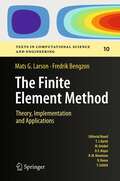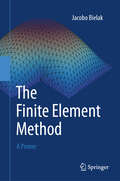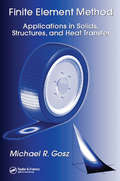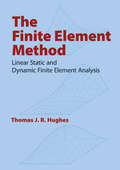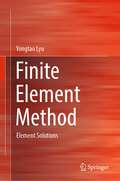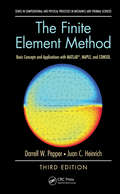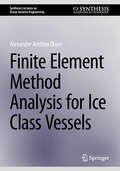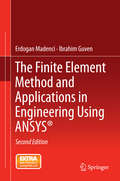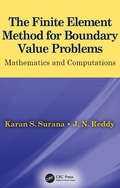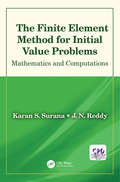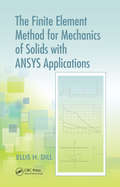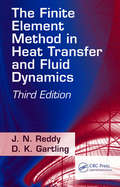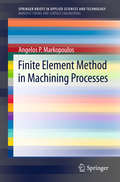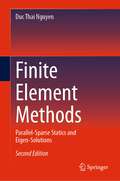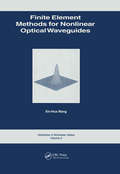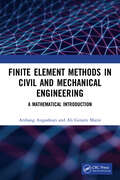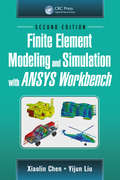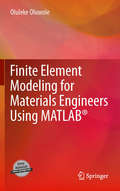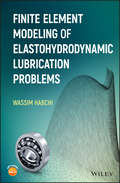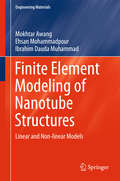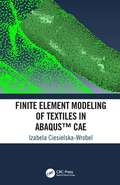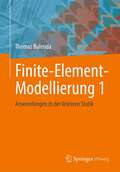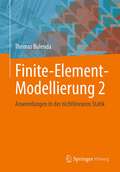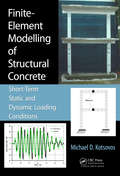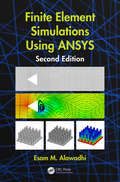- Table View
- List View
The Finite Element Method: Theory, Implementation, and Applications
by Fredrik Bengzon Mats G. LarsonThis book gives an introduction to the finite element method as a general computational method for solving partial differential equations approximately. Our approach is mathematical in nature with a strong focus on the underlying mathematical principles, such as approximation properties of piecewise polynomial spaces, and variational formulations of partial differential equations, but with a minimum level of advanced mathematical machinery from functional analysis and partial differential equations. In principle, the material should be accessible to students with only knowledge of calculus of several variables, basic partial differential equations, and linear algebra, as the necessary concepts from more advanced analysis are introduced when needed. Throughout the text we emphasize implementation of the involved algorithms, and have therefore mixed mathematical theory with concrete computer code using the numerical software MATLAB is and its PDE-Toolbox. We have also had the ambition to cover some of the most important applications of finite elements and the basic finite element methods developed for those applications, including diffusion and transport phenomena, solid and fluid mechanics, and also electromagnetics.
The Finite Element Method: A Primer
by Jacobo BielakThis textbook introduces the widely used numerical technique FEM in various engineering disciplines for the analysis of structures, heat transfer, fluid dynamics, and other physical phenomena. Appropriate for interested senior undergraduate engineering students and beginner graduate students in a one-semester introductory course, this book provides a clear understanding of the main issues in FEM. Looking at the FEM as a variational approximation method that uses localized piecewise polynomial basis functions for the solution of boundary-value problems (BVP) and initial boundary-value problems (IBVP), the book uses examples to apply this technique to various problems of physical interest, e.g., elasticity, heat conduction, advection-diffusion, etc. One-dimensional (1D) problems are presented first to make it easier to grasp the fundamental concepts associated with the formulation and application of the FEM; then, the methodology is extended to more challenging 2D and 3D problems that involve somewhat greater mathematical complexity. For simplicity, the book deals with problems that are specified in terms of a single set of state variables, such as displacements or temperature. Finally, due to the introductory nature of this text, only linear problems are considered.
Finite Element Method: Applications in Solids, Structures, and Heat Transfer (Mechanical Engineering)
by Michael R. GoszThe finite element method (FEM) is the dominant tool for numerical analysis in engineering, yet many engineers apply it without fully understanding all the principles. Learning the method can be challenging, but Mike Gosz has condensed the basic mathematics, concepts, and applications into a simple and easy-to-understand reference.Finite Element Method: Applications in Solids, Structures, and Heat Transfer navigates through linear, linear dynamic, and nonlinear finite elements with an emphasis on building confidence and familiarity with the method, not just the procedures. This book demystifies the assumptions made, the boundary conditions chosen, and whether or not proper failure criteria are used. It reviews the basic math underlying FEM, including matrix algebra, the Taylor series expansion and divergence theorem, vectors, tensors, and mechanics of continuous media.The author discusses applications to problems in solid mechanics, the steady-state heat equation, continuum and structural finite elements, linear transient analysis, small-strain plasticity, and geometrically nonlinear problems. He illustrates the material with 10 case studies, which define the problem, consider appropriate solution strategies, and warn against common pitfalls. Additionally, 35 interactive virtual reality modeling language files are available for download from the CRC Web site.For anyone first studying FEM or for those who simply wish to deepen their understanding, Finite Element Method: Applications in Solids, Structures, and Heat Transfer is the perfect resource.
The Finite Element Method: Linear Static and Dynamic Finite Element Analysis
by Thomas J. HughesOriginally developed to address specific areas of structural mechanics and elasticity, the finite element method is applicable to problems throughout applied mathematics, continuum mechanics, engineering, and physics. This text elucidates the method's broader scope, bridging the gap between mathematical foundations and practical applications. Intended for students as well as professionals, it is an excellent companion for independent study, with numerous illustrative examples and problems.The authors trace the method's development and explain the technique in clearly understandable stages. Topics include solving problems involving partial differential equations, with a thorough finite element analysis of Poisson's equation; a step-by-step assembly of the master matrix; various numerical techniques for solving large systems of equations; and applications to problems in elasticity and the bending of beams and plates. Additional subjects include general interpolation functions, numerical integrations, and higher-order elements; applications to second- and fourth-order partial differential equations; and a variety of issues involving elastic vibrations, heat transfer, and fluid flow. The displacement model is fully developed, in addition to the hybrid model, of which Dr. Tong was an originator. The text concludes with numerous helpful appendixes.
Finite Element Method: Element Solutions
by Yongtao LyuThis textbook is intended to be used by the senior engineering undergraduate and the graduate student. Nowadays, the finite element method has become one of the most widely used techniques in all the engineering fields, including aerospace engineering, mechanical engineering, biomedical engineering, etc. To unveil the FE technique, the textbook provides a detailed description of the finite element method, starting from the most important basic theoretical basis, e.g., the Galerkin method, the variational principle, followed by the detailed description of the various types of finite elements, including the bar, the beam, the triangular, the rectangular, the 3D elements. The primary aim of the textbook is to provide a comprehensive description of the FE solutions using different types of elements. Therefore, the properties of different elements and the solution discrepancies caused by using different elements are highlighted in the book. Thus, the textbook is very helpful for engineers to understand the behaviours of different types of elements. Additionally, the textbook can help the students and engineers write FE codes based on the theories presented in the book. Furthermore, the textbook can serve as the basis for some advanced computational mechanics courses, such as the nonlinear finite element method.
The Finite Element Method: Basic Concepts and Applications with MATLAB, MAPLE, and COMSOL (3rd Edition) (Series in Computational and Physical Processes in Mechanics and Thermal Sciences)
by Darrell W. Pepper Juan C. Heinrich<p>This self-explanatory guide introduces the basic fundamentals of the Finite Element Method in a clear manner using comprehensive examples. Beginning with the concept of one-dimensional heat transfer, the first chapters include one-dimensional problems that can be solved by inspection. The book progresses through more detailed two-dimensional elements to three-dimensional elements, including discussions on various applications, and ending with introductory chapters on the boundary element and meshless methods, where more input data must be provided to solve problems. Emphasis is placed on the development of the discrete set of algebraic equations. The example problems and exercises in each chapter explain the procedure for defining and organizing the required initial and boundary condition data for a specific problem, and computer code listings in MATLAB and MAPLE are included for setting up the examples within the text, including COMSOL files. <p>Widely used as an introductory Finite Element Method text since 1992 and used in past ASME short courses and AIAA home study courses, this text is intended for undergraduate and graduate students taking Finite Element Methodology courses, engineers working in the industry that need to become familiar with the FEM, and engineers working in the field of heat transfer. It can also be used for distance education courses that can be conducted on the web. Highlights of the new edition include:- Inclusion of MATLAB, MAPLE code listings, along with several COMSOL files, for the example problems within the text. Power point presentations per chapter and a solution manual are also available from the web.</p>
Finite Element Method Analysis for Ice Class Vessels (Synthesis Lectures on Ocean Systems Engineering)
by Alexander Arnfinn OlsenThis book provides ship designers with clear guidance on alternative design procedures for hull side structures, power requirements, and propeller strength assessment based on the Finite Element Method for Baltic Ice Class Vessels. Through this comprehensive guide, readers will learn the intricacies of designing vessels capable of navigating the harsh ice conditions of the Baltic Sea. The chapters cover topics such as ice strengthening designs using direct calculation approaches, power requirement calculations for ice class vessels, and strength analysis of propellers. The authors present an expert analysis of these critical aspects, offering practical solutions and methodologies that are essential for marine engineers and naval architects. This book is a must-read for anyone involved in the design and construction of ice-class vessels, providing invaluable insights into the latest research and best practices in the field. This guide is indispensable for naval architects, marine engineering students, marine surveyors, and professionals working in maritime defense and shipping registries. It serves as a reference for academics and students in marine design and engineering, as well as a textbook for marine engineering courses. With contributions from experienced practitioners in the field, this book offers both theoretical perspectives and practical case studies that will benefit anyone involved in the design and operation of ice-class vessels.
The Finite Element Method and Applications in Engineering Using ANSYS®
by Ibrahim Guven Erdogan MadenciThis textbook offers theoretical and practical knowledge of the finite element method. The book equips readers with the skills required to analyze engineering problems using ANSYS®, a commercially available FEA program. Revised and updated, this new edition presents the most current ANSYS® commands and ANSYS® screen shots, as well as modeling steps for each example problem. This self-contained, introductory text minimizes the need for additional reference material by covering both the fundamental topics in finite element methods and advanced topics concerning modeling and analysis. It focuses on the use of ANSYS® through both the Graphics User Interface (GUI) and the ANSYS® Parametric Design Language (APDL). Extensive examples from a range of engineering disciplines are presented in a straightforward, step-by-step fashion. Key topics include: * An introduction to FEM * Fundamentals and analysis capabilities of ANSYS® * Fundamentals of discretization and approximation functions * Modeling techniques and mesh generation in ANSYS® * Weighted residuals and minimum potential energy * Development of macro files * Linear structural analysis * Heat transfer and moisture diffusion * Nonlinear structural problems * Advanced subjects such as submodeling, substructuring, interaction with external files, and modification of ANSYS®-GUI Supplementary materials for this book may be downloaded from http://extras. springer. com. This convenient online feature, which includes color figures, screen shots and input files for sample problems, allows for regeneration on the reader's own computer. Students, researchers, and practitioners alike will find this an essential guide to predicting and simulating the physical behavior of complex engineering systems.
The Finite Element Method for Boundary Value Problems: Mathematics and Computations (Applied and Computational Mechanics)
by Karan S. Surana J. N. ReddyWritten by two well-respected experts in the field, The Finite Element Method for Boundary Value Problems: Mathematics and Computations bridges the gap between applied mathematics and application-oriented computational studies using FEM. Mathematically rigorous, the FEM is presented as a method of approximation for differential operators that are mathematically classified as self-adjoint, non-self-adjoint, and non-linear, thus addressing totality of all BVPs in various areas of engineering, applied mathematics, and physical sciences. These classes of operators are utilized in various methods of approximation: Galerkin method, Petrov-Galerkin Method, weighted residual method, Galerkin method with weak form, least squares method based on residual functional, etc. to establish unconditionally stable finite element computational processes using calculus of variations. Readers are able to grasp the mathematical foundation of finite element method as well as its versatility of applications. h-, p-, and k-versions of finite element method, hierarchical approximations, convergence, error estimation, error computation, and adaptivity are additional significant aspects of this book.
The Finite Element Method for Initial Value Problems: Mathematics and Computations
by Karan S. Surana J. N. Reddy<p>Unlike most finite element books that cover time dependent processes (IVPs) in a cursory manner, The Finite Element Method for Initial Value Problems: Mathematics and Computations focuses on the mathematical details as well as applications of space-time coupled and space-time decoupled finite element methods for IVPs. Space-time operator classification, space-time methods of approximation, and space-time calculus of variations are used to establish unconditional stability of space-time methods during the evolution. Space-time decoupled methods are also presented with the same rigor. Stability of space-time decoupled methods, time integration of ODEs including the finite element method in time are presented in detail with applications. Modal basis, normal mode synthesis techniques, error estimation, and a posteriori error computations for space-time coupled as well as space-time decoupled methods are presented. This book is aimed at a second-semester graduate level course in FEM.
The Finite Element Method for Mechanics of Solids with ANSYS Applications (Advances in Engineering Series)
by Ellis H. DillWhile the finite element method (FEM) has become the standard technique used to solve static and dynamic problems associated with structures and machines, ANSYS software has developed into the engineer's software of choice to model and numerically solve those problems. An invaluable tool to help engineers master and optimize analysis, The Finite El
The Finite Element Method in Heat Transfer and Fluid Dynamics (Applied and Computational Mechanics)
by J. N. Reddy D.K. GartlingAs Computational Fluid Dynamics (CFD) and Computational Heat Transfer (CHT) evolve and become increasingly important in standard engineering design and analysis practice, users require a solid understanding of mechanics and numerical methods to make optimal use of available software. Considered to be among the very best in the field, this masterwork from renowned experts J. N. Reddy and D. K. Gartling is the latest version of a book that has long been relied upon by practicing engineers, researchers, and graduate students. Noted for its powerful methodology and clear explanations of the subject, this third edition contains considerably more workable exercises and examples associated with problems in heat conduction, incompressible viscous flow, and convection heat transfer. It also uses applied examples to illustrate applications of FEM in thermal and fluid design analysis.
Finite Element Method in Machining Processes
by Angelos P. MarkopoulosFinite Element Method in Machining Processes provides a concise study on the way the Finite Element Method (FEM) is used in the case of manufacturing processes, primarily in machining. The basics of this kind of modeling are detailed to create a reference that will provide guidelines for those who start to study this method now, but also for scientists already involved in FEM and want to expand their research. A discussion on FEM, formulations, and techniques currently in use is followed up by machining case studies. Orthogonal cutting, oblique cutting, 3D simulations for turning and milling, grinding, and state-of-the-art topics such as high speed machining and micromachining are explained with relevant examples. This is all supported by a literature review and a reference list for further study. As FEM is a key method for researchers in the manufacturing and especially in the machining sector, Finite Element Method in Machining Processes is a key reference for students studying manufacturing processes but also for industry professionals.
Finite Element Methods: Parallel-Sparse Statics and Eigen-Solutions
by Duc Thai NguyenThis new edition includes three new chapters, 7 through 9, that have very broad, practical applications in engineering and science. In addition, the author’s latest research results incorporated into the new textbook demonstrates better performance than the popular METIS software for partitioning graphs, partitioning finite element meshes, and producing fill-reducing orderings for sparse matrices. The new Chapter 8, and its pre-requisite, Chapter 7, present a state-of-the-art algorithm for computing the shortest paths for real-life (large-scale) transportation networks with minimum computational time. This approach has not yet appeared in any existing textbooks and it could open the doors for other transportation engineering applications. Chapter 9 vastly expands the scope of the previous edition by including sensitivity (gradient) computation and MATLAB’s built-in function “fmincon” for obtaining the optimum (or best) solution for general engineering problems.
Finite Element Methods for Nonlinear Optical Waveguides
by Xin-Hua WangThis book provides researchers at the forefront of nonlinear optical technologies with robust procedures and software for the systematic investigation of the fundamental phenomena in nonlinear optical waveguide structures. A full vectorial electromagnetic formulation is adopted and the conditions under which simplification to a scalar formulation is possible are clearly indicated. The need to model the dielectric saturation properly is identified, and improved algorithms are presented for obtaining the complete power dispersion curve of structures exhibiting bistability. As the stability analysis of nonlinear modes is crucial to the development of nonlinear model methods, an effective procedure to investigate the propagation of the scalar nonlinear waves in 3D is another important feature of the book. All of the procedures described, as well as an automatic mesh generator for the finite element method, are incorporated into a software package which is included with this book.
Finite Element Methods in Civil and Mechanical Engineering: A Mathematical Introduction
by Arzhang Angoshtari Ali Gerami MatinThe finite element method is widely employed for numerical simulations in engineering and science due to its accuracy and efficiency. This concise introduction to the mathematical theory of the finite element method presents a selection of applications in civil and mechanical engineering including beams, elastic membranes, the wave equation, heat transfer, seepage in embankment, soil consolidation, incompressible fluids, and linear elasticity. Jupyter notebooks containing all Python programs of each chapter can be downloaded from the book's companion website. Arzhang Angoshtari is an assistant professor and Ali Gerami Matin is a graduate student, both in the department of Civil and Environmental Engineering at the George Washington University, USA. Their research interests cover theoretical and computational mechanics and finite element methods.
Finite Element Modeling and Simulation with ANSYS Workbench, Second Edition
by Xiaolin Chen Yijun LiuFinite Element Modeling and Simulation with ANSYS Workbench 18, Second Edition, combines finite element theory with real-world practice. Providing an introduction to finite element modeling and analysis for those with no prior experience, and written by authors with a combined experience of 30 years teaching the subject, this text presents FEM formulations integrated with relevant hands-on instructions for using ANSYS Workbench 18. Incorporating the basic theories of FEA, simulation case studies, and the use of ANSYS Workbench in the modeling of engineering problems, the book also establishes the finite element method as a powerful numerical tool in engineering design and analysis. Features Uses ANSYS Workbench™ 18, which integrates the ANSYS SpaceClaim Direct Modeler™ into common simulation workflows for ease of use and rapid geometry manipulation, as the FEA environment, with full-color screen shots and diagrams. Covers fundamental concepts and practical knowledge of finite element modeling and simulation, with full-color graphics throughout. Contains numerous simulation case studies, demonstrated in a step-by-step fashion. Includes web-based simulation files for ANSYS Workbench 18 examples. Provides analyses of trusses, beams, frames, plane stress and strain problems, plates and shells, 3-D design components, and assembly structures, as well as analyses of thermal and fluid problems.
Finite Element Modeling for Materials Engineers Using MATLAB®
by Oluleke OluwoleThe finite element method is often used for numerical computation in the applied sciences. It makes a major contribution to the range of numerical methods used in the simulation of systems and irregular domains, and its importance today has made it an important subject of study for all engineering students. While treatments of the method itself can be found in many traditional finite element books, Finite Element Modeling for Materials Engineers Using MATLAB® combines the finite element method with MATLAB to offer materials engineers a fast and code-free way of modeling for many materials processes. Finite Element Modeling for Materials Engineers Using MATLAB® covers such topics as: developing a weak formulation as a prelude to obtaining the finite element equation,interpolation functions,derivation of elemental equations, anduse of the Partial Differential Equation ToolboxTM.Exercises are given based on each example and m-files based on the examples are freely available to readers online. Researchers, advanced undergraduate and postgraduate students, and practitioners in the fields of materials and metallurgy will find Finite Element Modeling for Materials Engineers Using MATLAB® a useful guide to using MATLAB for engineering analysis and decision-making.
Finite Element Modeling of Elastohydrodynamic Lubrication Problems
by Wassim HabchiCovers the latest developments in modeling elastohydrodynamic lubrication (EHL) problems using the finite element method (FEM) This comprehensive guide introduces readers to a powerful technology being used today in the modeling of elastohydrodynamic lubrication (EHL) problems. It provides a general framework based on the finite element method (FEM) for dealing with multi-physical problems of complex nature (such as the EHL problem) and is accompanied by a website hosting a user-friendly FEM software for the treatment of EHL problems, based on the methodology described in the book. Finite Element Modeling of Elastohydrodynamic Lubrication Problems begins with an introduction to both the EHL and FEM fields. It then covers Standard FEM modeling of EHL problems, before going over more advanced techniques that employ model order reduction to allow significant savings in computational overhead. Finally, the book looks at applications that show how the developed modeling framework could be used to accurately predict the performance of EHL contacts in terms of lubricant film thickness, pressure build-up and friction coefficients under different configurations. Finite Element Modeling of Elastohydrodynamic Lubrication Problems offers in-depth chapter coverage of Elastohydrodynamic Lubrication and its FEM Modeling, under Isothermal Newtonian and Generalized-Newtonian conditions with the inclusion of Thermal Effects; Standard FEM Modeling; Advanced FEM Modeling, including Model Order Reduction techniques; and Applications, including Pressure, Film Thickness and Friction Predictions, and Coated EHL. This book: Comprehensively covers the latest technology in modeling EHL problems Focuses on the FEM modeling of EHL problems Incorporates advanced techniques based on model order reduction Covers applications of the method to complex EHL problems Accompanied by a website hosting a user-friendly FEM-based EHL software Finite Element Modeling of Elastohydrodynamic Lubrication Problems is an ideal book for researchers and graduate students in the field of Tribology.
Finite Element Modeling of Nanotube Structures
by Ibrahim Dauda Muhammad Ehsan Mohammadpour Mokhtar AwangThis book presents a new approach to modeling carbon structures such as graphene and carbon nanotubes using finite element methods, and addresses the latest advances in numerical studies for these materials. Based on the available findings, the book develops an effective finite element approach for modeling the structure and the deformation of grapheme-based materials. Further, modeling processing for single-walled and multi-walled carbon nanotubes is demonstrated in detail.
Finite Element Modeling of Textiles in Abaqus™ CAE
by Izabela Ciesielska-WrobelThe aim of the book is to provide engineers with a practical guide to Finite Element Modelling (FEM) in Abaqus CAE software. The guide is in the form of step-by-step procedures concerning yarns, woven fabric and knitted fabrics modelling, as well as their contact with skin so that the simulation of haptic perception between textiles and skin can be
Finite-Element-Modellierung 1: Anwendungen in der linearen Statik
by Thomas BulendaEs gibt eine Vielzahl von „Wie-erstelle-ich-ein Finite-Element-Programm?“-Lehrbüchern, aber nur recht wenige Veröffentlichungen zur Frage „Wie wende ich ein Finite-Element-Programm an?“. Dieses Buch legt den Schwerpunkt auf die zweite Fragestellung. Es basiert auf den Vorlesungen zur Anwendung der Finite-Element-Methode, die der Autor seit 1998 an der OTH Regensburg hält. Deren Inhalte kommen aus seiner Tätigkeit als Prüfingenieur für Baustatik in einem großen Münchener Ingenieurbüro. Behandelt werden sowohl Fragestellungen, mit denen sich jeder Ingenieur konfrontiert sieht, wenn er Berechnungen mit einem Finite-Element-Programm erstellen will, als auch Problempunkte, die im Büro des Autors im Zuge einer Projektbearbeitung auftraten und auf den ersten Blick gar nicht so klar waren. In Teil 1 des zweibändigen Werks werden Themen aus der linearen Statik behandelt.
Finite-Element-Modellierung 2: Anwendungen in der nichtlinearen Statik
by Thomas BulendaEs gibt eine Vielzahl von „Wie-erstelle-ich-ein Finite-Element-Programm?“-Lehrbüchern, aber nur recht wenige Veröffentlichungen zur Frage „Wie wende ich ein Finite-Element-Programm an?“. Dieses Buch legt den Schwerpunkt auf die zweite Fragestellung. Es basiert auf den Vorlesungen zur Anwendung der Finite-Element-Methode, die der Autor seit 1998 an der OTH Regensburg hält. Deren Inhalte kommen aus seiner Tätigkeit als Prüfingenieur für Baustatik in einem großen Münchener Ingenieurbüro. Behandelt werden sowohl Fragestellungen, mit denen sich jeder Ingenieur konfrontiert sieht, wenn er Berechnungen mit einem Finite-Element-Programm erstellen will, als auch Problempunkte, die im Büro des Autors im Zuge einer Projektbearbeitung auftraten und auf den ersten Blick gar nicht so klar waren. Der 2.Teil des zweibändigen Werkes befasst sich mit Themen aus der nichtlinearen Statik.
Finite-Element Modelling of Structural Concrete: Short-Term Static and Dynamic Loading Conditions
by Michael D. KotsovosA Powerful Tool for the Analysis and Design of Complex Structural ElementsFinite-Element Modelling of Structural Concrete: Short-Term Static and Dynamic Loading Conditions presents a finite-element model of structural concrete under short-term loading, covering the whole range of short-term loading conditions, from static (monotonic and cyclic) to
Finite Element Simulations Using ANSYS
by Esam M. AlawadhiUses a Step-By-Step Technique Directed with Guided Problems and Relevant Screen Shots Simulation use is on the rise, and more practicing professionals are depending on the reliability of software to help them tackle real-world mechanical engineering problems. Finite Element Simulations Using ANSYS, Second Edition offers a basic understanding of the
